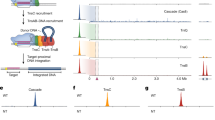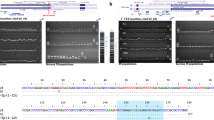Abstract
As in the case of retrovirus proviruses, most of the Drosophila copia-like transposable elements so far examined are bounded by 5′TG…CA3′ and inserted into the chromosome without obvious site-specificity1–4. In the other copia-like elements, 297, HMS Beagle and 17.6 (refs 5–7), terminal dinucleotides (5′TG…CA3′) are completely absent and, instead, 5′(A)GT is present at least at one of the termini. One important feature of these three elements may be frequent insertion into ‘TATA’ boxes, since the three of four insertion sites so far examined were TATA boxes, two for H3 histone genes5,8 and one for a cuticle gene6. Because of the importance of this type of insertion, we extensively analysed site-specificity using 17.6 as a model. Our results, described here, suggest that insertion of 17.6 takes place in a site-specific fashion, using a target 5′ATAT corresponding to the major portion of the consensus TATA box9, TATAATAAT.
This is a preview of subscription content, access via your institution
Access options
Subscribe to this journal
Receive 51 print issues and online access
$199.00 per year
only $3.90 per issue
Buy this article
- Purchase on SpringerLink
- Instant access to full article PDF
Prices may be subject to local taxes which are calculated during checkout
Similar content being viewed by others
References
Rubin, G. M. et al. Cold Spring Harb. Symp. quant. Biol. 45, 619–628 (1981).
Kulguskin, V. V., Ilyin, Y. V. & Georgiev, G. P. Nucleic Acids Res. 9, 3451–3463 (1981).
Will, B. M., Bayev, A. A. & Finnegan, D. J. J. molec. Biol. 153, 897–915 (1981).
Scherer, G., Tschudi, C., Perera, J., Delius, H. & Pirrotta, V. J. molec. Biol. 157, 435–451 (1981).
Ikenaga, H. & Saigo, K. Proc. natn. Acad. Sci. U.S.A. 79, 4143–4147 (1982).
Snyder, M. et al. Proc. natn. Acad. Sci. U.S.A. 79, 7430–7434 (1982).
Kugimiya, W., Ikenaga, H. & Saigo, K. Proc. natn. Acad. Sci. U.S.A. 80, 3193–3197 (1983).
Goldberg, M. L. thesis, Stanford Univ. (1979).
Breathnach, R. & Chambon, P. A. Rev. Biochem. 50, 349–383 (1981).
Saigo, K., Millstein, L. & Thomas, C. A. Jr Cold Spring Harb. Symp. quant. Biol. 45, 815–827 (1981).
Vieira, J. & Messing, J. Gene 19, 259–268 (1982).
Spradling, A. C. & Rubin, G. M. A. Rev. Genet. 15, 219–264 (1981).
Swanstrom, R., DeLorbe, W. J., Bishop, J. M. & Varmus, M. E. Proc. natn. Acad. Sci. U.S.A. 78, 124–128 (1981).
Maniatis, T. et al. Cell 16, 687–701 (1978).
Maxam, A. M. & Gilbert, W. Meth. Enzym. 65, 499–560 (1980).
Author information
Authors and Affiliations
Rights and permissions
About this article
Cite this article
Inouye, S., Yuki, S. & Saigo, K. Sequence-specific insertion of the Drosophila transposable genetic element 17.6. Nature 310, 332–333 (1984). https://doi.org/10.1038/310332a0
Received:
Accepted:
Issue date:
DOI: https://doi.org/10.1038/310332a0
This article is cited by
-
Genomic distribution of retrotransposons 297, 1731, copia, mdg1 and roo in the Drosophila melanogaster species subgroup
Genetica (2010)
-
The transposable elements of the Drosophila melanogaster euchromatin: a genomics perspective
Genome Biology (2002)
-
Tirant: A new retrotransposon-like element inDrosophila melanogaster
Journal of Molecular Evolution (1996)
-
TheTy1-copia group retrotransposons ofAllium cepa are distributed throughout the chromosomes but are enriched in the terminal heterochromatin
Chromosome Research (1996)
-
Transposable elements map in a conserved pattern of distribution extending from beta-heterochromatin to centromeres in Drosophila melanogaster
Chromosoma (1995)



